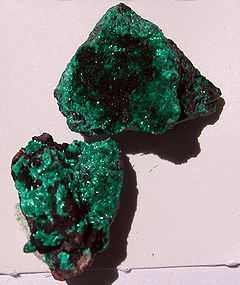Brochantite
From Wikipedia, the free encyclopedia
| Brochantite | |
|---|---|
 | |
| General | |
| Category | Sulfate minerals |
| Formula (repeating unit) | Cu4SO4(OH)6 |
| Strunz classification | 07.BB.25 |
| Identification | |
| Color | Green, emerald green, or black |
| Crystal habit | Prismatic crystals; acicular needle-like crystals; druse |
| Crystal system | Monoclinic |
| Cleavage | Perfect [100] |
| Fracture | Conchoidal - brittle |
| Mohs scale hardness | 3.5 - 4.0 |
| Luster | Vitreous - pearly |
| Streak | Pale green |
| Diaphaneity | Transparent to translucent |
| Specific gravity | 3.97 |
| Optical properties | Biaxial (-), 2V measured: 72° |
| Refractive index | nα = 1.728 nβ = 1.771 nγ = 1.800 |
| Birefringence | δ = 0.072 |
| Pleochroism | Weak |
| References | [1][2][3] |
Brochantite is a sulfate mineral, one of a number of cupric sulfates. Its chemical formula is CuSO4·3Cu(OH)2. Formed in arid climates or in rapidly oxidizing copper sulfide deposits, it is named for its discoverer, the French geologist and mineralogist, A. J. M. Brochant de Villiers (1772–1840).
Crystals of brochantite can range from emerald green to black-green to blue-green, and can be acicular or prismatic. Brochantite is often associated with minerals such as malachite, azurite, and chrysocolla, and may form pseudomorphs with these minerals.
The mineral is found in a number of locations around the world, notably the southwestern United States (especially Arizona), Serifos in Greece and Chile.
References
- ↑ http://webmineral.com/data/Brochantite.shtml Webmineral
- ↑ http://rruff.geo.arizona.edu/doclib/hom/brochantite.pdf Mineral Handbook
- ↑ http://www.mindat.org/min-779.html Mindat
External links
 Spencer, Leonard James (1911). "Brochantite". In Chisholm, Hugh. Encyclopædia Britannica 4 (11th ed.). Cambridge University Press
Spencer, Leonard James (1911). "Brochantite". In Chisholm, Hugh. Encyclopædia Britannica 4 (11th ed.). Cambridge University Press
This article is issued from Wikipedia. The text is available under the Creative Commons Attribution/Share Alike; additional terms may apply for the media files.